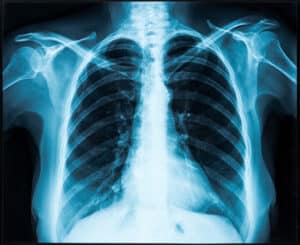Thoracic Injury
Home » Personal Injury Resources » Types of Injuries » Thoracic Injury

Your thoracic cavity contains your heart, lungs, and major blood vessels. Your ribcage protects these vital organs from injuries, except in the most severe accidents.
Fortunately, thoracic injuries do not happen often. But when they do occur, they can cause long-term organ damage and can even be fatal.
Table of Contents
What Is a Thorax?

Biologists divide bodies into three segments — head, thorax, and abdomen. The head contains the brain. The abdomen contains the digestive system and connects to the lower limbs. In a human, the abdominal cavity sits below the diaphragm and runs to the pelvis.
The thorax sits between the head and the abdomen. Doctors often refer to the thorax as the chest. It covers the area between the shoulders and the bottom of the ribcage.
The word “thorax” means the same as “chest.” But doctors often distinguish between chest injuries and thoracic injuries based on whether the injury affects the outside or inside of your chest. Chest injuries damage the musculoskeletal sections of the chest, while thoracic injuries damage the organs inside the chest.
The thoracic cavity contains vital organs, such as your heart, lungs, and major blood vessels. The trachea and esophagus also run through the thoracic cavity from your mouth to your lungs and stomach, and several major nerves sit in the thorax. These nerves control the thoracic and abdominal organs.
How Do Thoracic Injuries Happen?
The rib cage protects the thoracic cavity. But you can still suffer injuries to the thoracic organs. This can happen in a couple of ways, including:
Penetrating Trauma
Penetrating trauma happens when an object pierces your chest and leaves an open wound. Penetrating trauma can produce thoracic injuries by lacerating or tearing the tissues inside your chest cavity. An object can also produce internal bleeding that deprives your organs of the necessary oxygen and nutrients.
Internal bleeding can put pressure on your organs as well. When your heart, lungs, and blood vessels get squeezed, they might not function correctly. Your respiration, blood pressure, and heart rate can drop.
Penetrating trauma can happen in falls. For example, a nail or something sharp could get propelled into your chest in a construction accident. Likewise, your handlebars or broken frame could penetrate your chest in a bicycle accident.
Blunt Trauma
You suffer blunt trauma when something hits your chest without piercing the thoracic cavity. Even though the object does not create an open wound, it can still damage structures inside your thorax.
Internal organs can rupture due to the pressure and strain from an impact on the chest. Nerve tissue can misfire when it gets stretched or torn. And organs like the heart, lungs, and blood vessels operate at finely tuned pressures that can get disrupted by internal bleeding.
Blunt trauma can also break ribs. The broken ribs can penetrate your thoracic cavity and damage vital organs. They can also produce internal bleeding that can cause your blood pressure to drop, leading to shock.
Blunt trauma can happen in two of the most common types of accidents — falls and car accidents. In an elevated fall or a slip and fall accident, you can hit your chest on the ground. The impact can damage the organs inside the chest cavity.
In a car accident, your chest can get injured when you hit your:
- Seat belt
- Steering wheel
- Dashboard
- Airbag
Most of the time, you only suffer chest injuries. But a severe impact can cause thoracic injuries to your vital organs.
What Are Some Examples of Thoracic Injuries?
Thoracic injuries can take many different forms, depending on the organs that get damaged. Some types of thoracic injuries include:
Collapsed Lung
A collapsed lung happens when an injury compromises the vacuum between the lungs and the chest cavity wall. Without this vacuum, the lungs collapse and cannot re-expand. You may struggle to breathe because you cannot inhale. Your heart, brain, and other organs get deprived of oxygen, and the tissues may begin to die.
Without emergency treatment, you can suffer permanent lung damage. To treat a collapsed lung, emergency responders remove whatever has surrounded the lungs so the lungs can re-expand. They then patch the wound so the chest cavity can maintain a vacuum.
A collapsed lung can happen in two ways:
Pneumothorax
Pneumothorax happens when a penetrating injury allows air to enter the chest. The pressure squeezes the lungs and causes them to collapse.
Hemothorax
Hemothorax occurs when internal bleeding causes blood to surround the lungs. In this case, fluid pressure collapses them.
Cardiac Tamponade
The pericardium surrounds your heart and protects it from infections. It also forms a barrier, so your heart can beat without rubbing on other tissues.
After an injury, the pericardium can fill with fluid. In this injury, called cardiac tamponade, the fluid strangles your heart and causes it to beat irregularly. Emergency surgery can drain the fluid so your heart can beat properly.
Aortic Tear
Your blood circulates to your lungs to pick up oxygen, then to your body to carry the oxygen to your cells. When the blood leaves the heart, it passes through the aorta.
Chest trauma can tear the aorta. Since all the blood in your body passes through the aorta, you can bleed to death in a matter of minutes after an aortic tear. In most cases, an aortic tear can be fatal without immediate emergency surgery.
How Can You Get Compensation for a Thoracic Injury?
You may be able to seek compensation for thoracic injuries suffered due to someone else’s actions. To recover compensation, you must prove negligence.
Negligence means that someone failed to exercise reasonable care. For example, a driver who runs a red light or a shop owner who ignores a spill may have acted negligently.
When you prove negligence, you can seek compensation for economic damages, which may include medical expenses and lost wages. You can also seek compensation for non-economic damages like pain, suffering, and disability.
Thoracic injuries can cause grievous harm and life-threatening organ damage. You do not have to suffer the consequences of these injuries alone. At M&Y Personal Injury Lawyers, we have recovered over $400 million in compensation for our clients to help them achieve the justice they deserve.To discuss the compensation you can seek for your thoracic injury in Los Angeles, contact the M&Y Personal Injury Lawyers for a free consultation at 866-864-5477.
